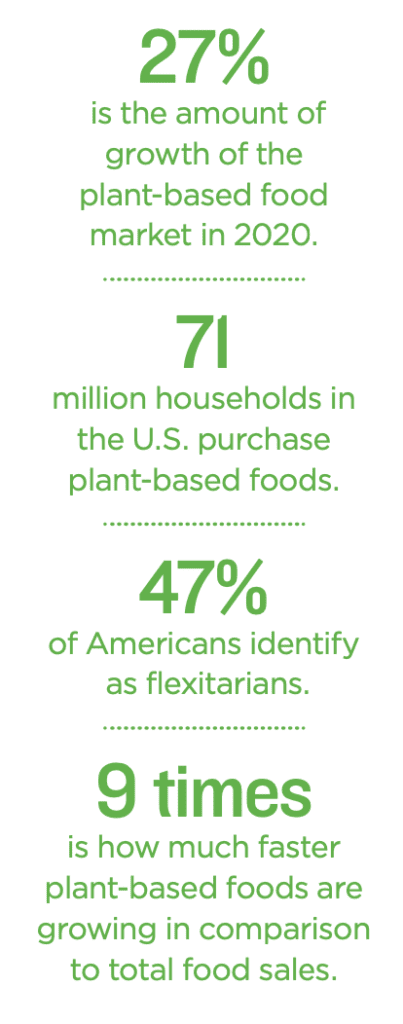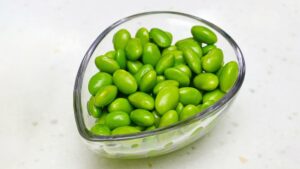Within the decade, the plant-based proteins sector is expected to grow to $140 billion. The industry ramps up for change.
There’s a new area of agriculture that’s growing at an extremely fast pace. It’s sustainable, but controversial to the seed industry at the same time… Did you guess what it is?
Alternative proteins are quickly growing in the meat market, so much so that by 2027, Meticulous Market Research predicts that they’ll reach $27.05 billion. But why are food companies looking into alternative proteins so much, and why is the market continuously growing each year?
Alternative proteins, be it made from soybeans, yellow pea or other ingredients, are proving to be a more sustainable option in comparison to the typical meats you’d find in the grocery store. They reduce the environmental burden with less water use, land use, feed use and greenhouse gas emissions, the research report continues.

“The plant-based protein category offers us a unique opportunity and time to link the consumer interest with farmer benefit,” says Matt Crisp, CEO of Benson Hill. “The reason why we’re so excited about this space, aside from the sustainability and environmental benefits, is the fact that it’s growing so fast.”
Crisp categorizes alternative proteins as a level of growth unlike many in the food industry have ever seen, which provides plenty of opportunity for seed companies and tech companies alike.
Fueled by a New Mindset
Over the past two years, Nicole Sopko says plant-based food sales grew 43% — a whopping nine times faster than total food sales, up to $7 billion.
Sopko, vice president of Upton’s Naturals and president of the board for the Plant-Based Foods Association, was one of the panelists at the American Seed Trade Association’s (ASTA) CSS & Seed Expo on alternative proteins on Dec. 6.
“Plant-based foods grew 27% in 2020, which was over two times the growth in 2019,” Sopko says. “Consumers indicate that they are motivated to purchase plant-based foods based on health, sustainability and animal welfare.”
Crisp says they’ve seen significant growth in this area largely due to a growing middle class.
“It’s our belief that the demand for protein in a global sense will continue to grow irrespective of the medium through which it’s consumed,” he says. “Feed markets that fuel animal protein solutions and plant-based markets are both growing.”
However, Crisp says when they look at the meat alternatives, it was accelerated by the pandemic.
“I think it’s accelerated because we’re becoming more aware of what we eat and where it comes from,” he says. “So, we’re looking for more nutritious, more sustainable food solutions and ingredient solutions.”
In addition, Sopko says that 57% or 71 million households purchase plant-based foods, which is up 4%, and 47% of Americans are identifying as flexitarians.
“Those who are actively seeking to reduce animal-based meat and dairy choose to eat it only occasionally,” she says. “Seventy-eight percent of shoppers who are purchasing plant-based foods are repeat and loyal shoppers.”
With the numbers speaking volumes of the consumer demand for plant-based foods, Sopko says it’s important to remember there are crop benefits as well.
“The top crops used to make plant-based ingredients are soybeans, dried peas, chickpeas, oats and wheat,” she says. “Growing these crops as part of a diversified cover rotation will have multiple climate benefits starting with soil conservation and water quality.”
In addition to the benefits of diversification, plant-based proteins are also starting to pull crops out of more region-specific areas. Take pulse crops, for example.
“As this investment grows, you’re going to see the pulse world move out of Saskatchewan and out of Montana and spreading further,” says Mark Macrander, director of specialty grains at Ingredion during the ASTA panel. “For old agronomists, it’s exciting to see the work in pulses help increase that acreage to help meet the customer demand.”
For companies like Impossible Foods, creator of the Impossible Burger, those new ingredients are key for alternative proteins.
“All of our main commodity ingredients are being sourced from the U.S.,” says Tyler Jameson, vice president of government relations for Impossible Foods. “That would be primarily soybeans and sunflower oil.”
So, what should food ingredient companies do to respond to this ever-increasing demand and market?
What Does It Mean for Ingredients?
When it comes to ingredient companies like Benson Hill, they’ve heard the call and the demand. Benson Hill has developed a high-protein soybean and is exploring opportunities in yellow pea, both made to be food-grade ingredients for markets such as the alternative protein sector.

“It comes down to preference,” Crisp says. “We’re intending to have multiple crops in the portfolio to offer our customers choice. Some folks prefer a yellow pea ingredient solution, like Beyond Meat, whereas Impossible uses a soy base for most of their products. Soy is the most predominate alternative protein source used in plant-based meat products. Yellow pea, on the other hand isn’t as big in the market, but it’s fast growing.”
The challenge in the soybean market, though? The expenses.
“Market research would inform us that the plant-based meat alternatives market, on a global basis, will reach $140 billion this decade,” Crisp says. “If we’re really going to make it more accessible and realize that type of growth, we’ve got to make these solutions more affordable.”
Largely, the expenses come down to cost of processing.
“In order to concentrate the protein today, to a high enough level to make a texturized plant-based protein ingredient, the industry has to concentrate it further through a soy protein concentrate — which is really water and energy intensive,” Crisp says. “It’s also really expensive. That’s the primary reason why you see significant price premiums above and beyond what you would otherwise sell as commodity.”
One solution that Benson Hill worked on is a high protein non-GMO soybean.
“If we can let Mother Nature do the hard work and concentrate that protein for us in the seed, then we don’t need to go and pay for this very expensive water and energy intensive processing,” he says. “We can use that natural genetic diversity of the plant and move it more directly as a whole ingredient to our customer base.”
Grower engagement around alternative proteins is also continuously growing, and Benson Hill has been working with new farmer partners through their program called Plant for Protein.
“We’re on our third year of contracting for 2022 for proprietary soybean, and we’ve expanded from 30,000 acres to 70,000,” Crisp says. “This year, we’re intending to expand that significantly further, and we’ve had a really terrific return rate of growers we’ve worked with. It’s a milestone and indicator of the demand we’re seeing on the consumer side.”
Make sure to keep an eye on the alternative protein market as it continues to grow and rise with consumer demand.
This story was originally published in our sister publication Seed World.













